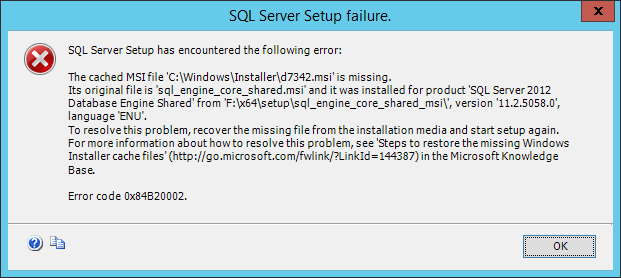Helping out a collegue I was asked to install features from SQL Server 2008R2 on an existing box. That sounded like something I could do with both hands tied and a blindfold on. But Boy was I in for a surprise.
The server, which had some features (SSAS mainly) from SQL Server 2012 SP2 installed, was to run SSIS packages from a SQL Server 2008R2 instance. Don’t ask why, just accept it 🙂
Initially I downloaded an iso file from MSDN, that would contain SQL Server 2008R2. Btw. if you ever need to mount an iso and do not have the feature in the OS, like in my example Windows 2008, visit Slysoft and download the Virtual Clone Drive (Free).
Running the installation from that media resultet in an unusual error, one which I haven’t seen before – and to be honest, I don’t get why this would ever be a problem. The error message tells you, that the chached file is missing and you have to copy the original, and rename it in the process, to C:\Windows\Install (which is a hidden folder). Let’s repeat that, a cached file is missing… WTF!
 Note that the cached file in question is related to the SQL Server 2012 installation, but this was SQL Server 2008R2…
Note that the cached file in question is related to the SQL Server 2012 installation, but this was SQL Server 2008R2…
Going by the link described in the error message, I am directed to a page that describes this error in detail, for a good deal of previous versions of SQL Server (2005, 2008, 2008R2 & 2012). The KB provides a script that lets you identify which files are actually missing. The output format of this script is questionable – some would say chatty. So to get the details that actually matter, a bit of regular expression comes in handy. This may well be one of the most simple regular expressions I have ever written, and I think everyone can understand without further introduction:
Copy ".+
This little beauty will pull out all the rows that begin with “Copy ” followed by any number of characters. The result from this query, can be pasted directly into a txt file, which then can be renamed to have .bat as postfix. Please note that you may need to do additional cleansing of the paths in the txt file before running it and you need the install media mounted on the box in question. One final note is to run a cmd prompt in elevated mode, and then kick off the bat job. This will copy the missing files to the Windows\Install folder.
Going through the output of the bat job, I can verify that all files have been copied succesfully. So you can imagine the surprise as I ran the installer once again and received below error message:
 Ohhhkay… As the aware reader you are, you will by now have noticed the reference to same KB as above.
Ohhhkay… As the aware reader you are, you will by now have noticed the reference to same KB as above.
 I had to find the file on the SQL Server install media, copy the file to my desktop, rename it and then copy/move that file into the Windows\Install directory.
I had to find the file on the SQL Server install media, copy the file to my desktop, rename it and then copy/move that file into the Windows\Install directory.
Getting back in installation mode, I kicked off the installation once more, selecting all the required features (no by default option) and then got the install going. Only to be met by a new error message:
 If you see keyboards flying, you know why…
If you see keyboards flying, you know why…
And yes, computer screens used to look like that 😉
![]()


 Please note the little green check mark indicating everything’s Dandy (
Please note the little green check mark indicating everything’s Dandy (
















